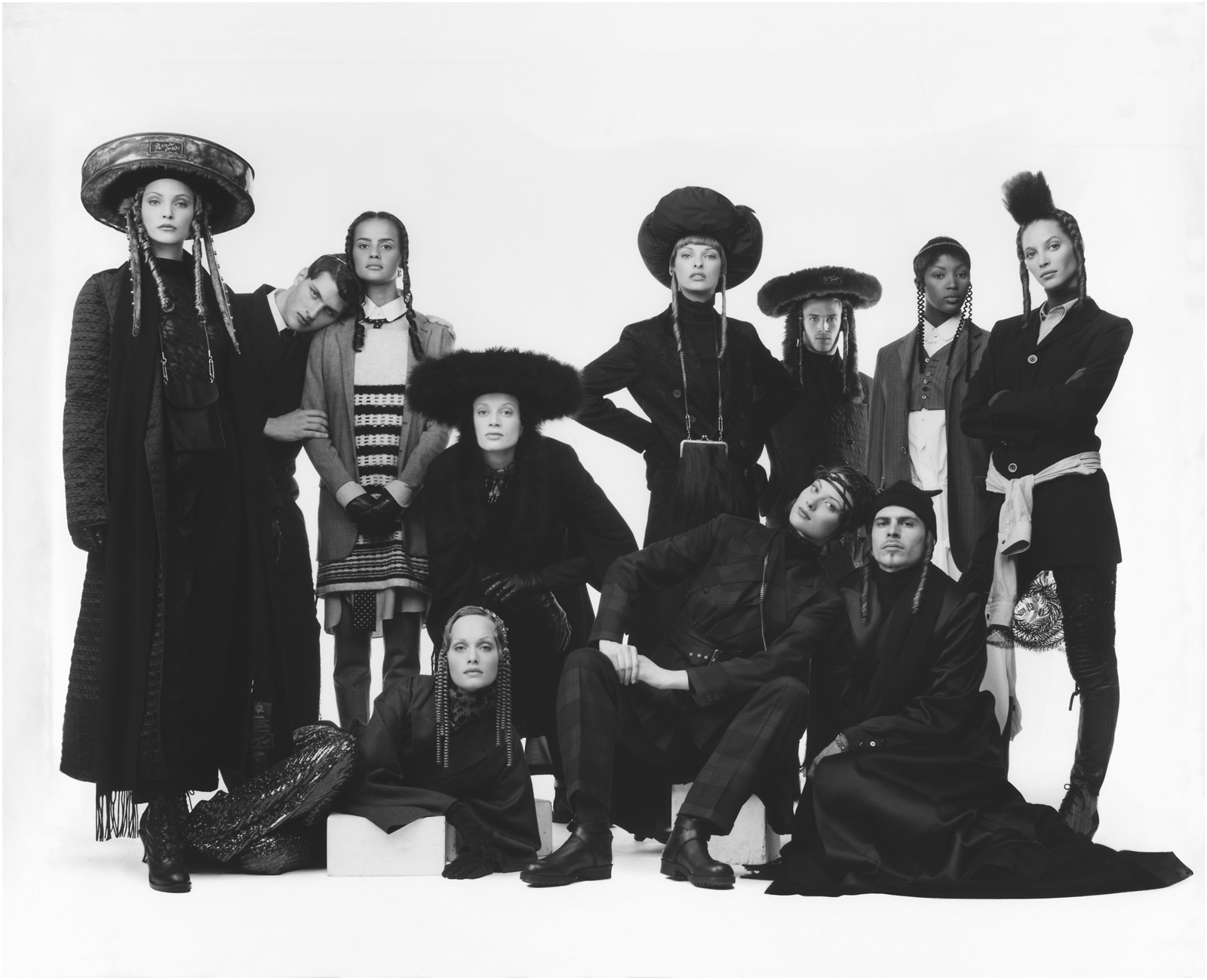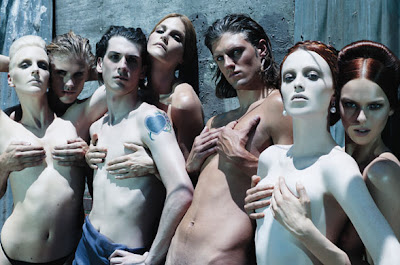
Steven Meisel (born 1954) is an American fashion photographer, who obtained popularity and critical acclaim with his work in US and Italian Vogue and his photographs of friend Madonna in her 1992 book Sex.

He is now considered one of the most successful fashion photographers in the industry, shooting regularly for both US and Italian Vogue, and lately W (also published by Condé Nast).
He was born in 1954. His fascination for beauty and models started at a young age.
(Steven Mieisel)
At that time Meisel would not play with toys, but would instead draw women all the time. He used to turn to magazines like Vogue and Harper's Bazaar as sources of inspiration for his drawings.
Meisel dreamt of women from the high society like Gloria Guinness and Babe Paley, who personified to his eyes the ideas of beauty and high society. Other icons were his mother and his sister.
As he became obsessed with models such as Twiggy, Veruschka, and Jean Shrimpton, at 12 years old he asked some girlfriends to call model agencies and, by pretending to be secretaries of Richard Avedon, to get pictures of the models. To meet famous model Twiggy, the 12-year-old Meisel stood outside waiting for her at Melvin Sokolsky's studio.
He studied at the High School of Art and Design and Parsons The New School for Design where he attended different courses but, as affirmed in an interview with Ingrid Sischy for Vogue France, he finally majored in fashion illustration.
One of Meisel's first jobs was to work for fashion designer Halston as an illustrator. He also taught illustration part-time at Parsons. Meisel never thought he could become a photographer. He admired photographers like Jerry Schatzberg, Irving Penn, Richard Avedon and Bert Stern. He felt that illustration was a thing of the past and found photography as a lasting medium. Later on, while working at Women's Wear Daily as an illustrator, he went to Elite Model Management where Oscar Reyes a booker who liked his illustrations allowed him take pictures of some of their models.

He would photograph them in his apartment in Gramercy Park or on the street: on weekdays he would work at Women's Wear Daily and on weekends with the models. One of them was Phoebe Cates. Some of these models went to castings for Seventeen magazine to show their portfolios which held some of his photography and the people at Seventeen subsequently called Meisel and asked if he wanted to work with them.
Meisel currently works for many different fashion magazines, including US and Italian Vogue, in which he has photographed every cover for two decades.
Meisel has contributed photos for the covers of several popular albums and singles, including two RIAA Diamond-certified albums, Madonna's 1984 album "Like a Virgin" and Mariah Carey's 1995 album Daydream.
His work also can be seen on the cover of Madonna's single "Bad Girl" (a nude), the limited picture disc for Madonna's UK single release of "Fever" (a partial nude), and Mariah Carey's single "Fantasy" (simply a different crop of the photo on the cover of the Daydream album).

Amongst others, Meisel has shot campaigns for Versace, Valentino, Dolce & Gabbana, Louis Vuitton, Balenciaga and Calvin Klein (for whom his campaigns were very controversial). Meisel also shoots Prada campaigns each season — having done so since 2004. In April 2008 he shot friend Madonna for Vanity Fair, and later in the year he shot her for the 2009 spring campaign by Louis Vuitton.
He is a close friend of designer Anna Sui for whom he also shot several campaigns, even though Sui rarely uses advertising to promote her clothing.
As one of the most powerful photographers in the fashion industry, Meisel is credited with "discovering" or promoting the careers of many successful models, including top models Linda Evangelista, Naomi Campbell, Nadège du Bospertus, Christy Turlington, Kristen McMenamy, Amber Valletta, Snejana Onopka, Iris Strubegger, Lara Stone, Coco Rocha, Caroline Trentini, Liya Kebede, Elise Crombez, Karen Elson, Doutzen Kroes, and Raquel Zimmerman, propelling them to fame by regularly featuring them in Vogue and various campaigns, notably Prada, considered one of the most desired campaigns in the business.

Meisel's influence and training seems to also extend past models. He used his influence among the fashion elite to create an issue of Vogue that would show only black models. He also launched the career of Ross Van Der Heide, a young fashion designer, by showing Ross's artwork to Anna Sui.
He launched the careers of many models and persuaded British model Karen Elson to shave her eyebrows off which earned her the nickname 'Le Freak'.
Meisel has been the force behind the careers of people he regularly used on his Vogue shoots; hairstylists Oribe Canales, Garren, Orlando Pita and Guido Palau, and make-up artists François Nars, Laura Mercier, Pat McGrath and the late Kevyn Aucoin owe some of their success to the photographer.
Meisel has been a protégé of both Franca Sozzani and Anna Wintour, editors-in-chief of Italian and American Vogue, respectively. For the former, he photographs the cover of every issue, something generally unheard of in the ever changing fashion industry.
Meisel often creates layouts which are controversial, by juxtaposing fashion and politics and/or social standards. For example, in the September 2006 issue of Vogue Italia', Meisel played with the concept of restricted liberties post-September 11 America, with the models portraying terrorists and highly trained policemen.
It caused a stir in the press, as the models were presented in violent compositions where they could be seen as being victimized. It also elicited a negative response from feminists which saw the role of the women as being undermined by their male counterparts. The July 2008 issue of Vogue Italia featured only black models, and was entirely photographed by Meisel. It was a response to increasing criticism of racism in the fashion industry and became the best-selling issue in the magazine's history.
When asked about the issue, Meisel said, "Obviously I feel that fashion is totally racist. The one thing that taking pictures allows you to do is occasionally make a larger statement. After seeing all the shows though I feel it was totally ineffective. I was curious—because it received a lot of publicity—whether it would have any effect on New York, London, Paris, or Milan, and I found that it did not. They still only had one token black girl, maybe two. It’s the same as it always was and that’s the sad thing for me."
Artist Rep agency Art + Commerce represents Steven Meisel for image licensing and advertising.
Meisel is notorious for rarely giving interviews or being photographed. However, in one of few cases, he was interviewed by Ingrid Sischy for Vogue Paris.
The following year, Meisel agreed to be interviewed for 032c magazine by Pierre-Alexandre de Looz. De Looz' piece, "Who Is Steven Meisel?", was accompanied by a 14-page fold-out retrospective of Meisel's twenty years of covers for Vogue Italia.



No comments:
Post a Comment